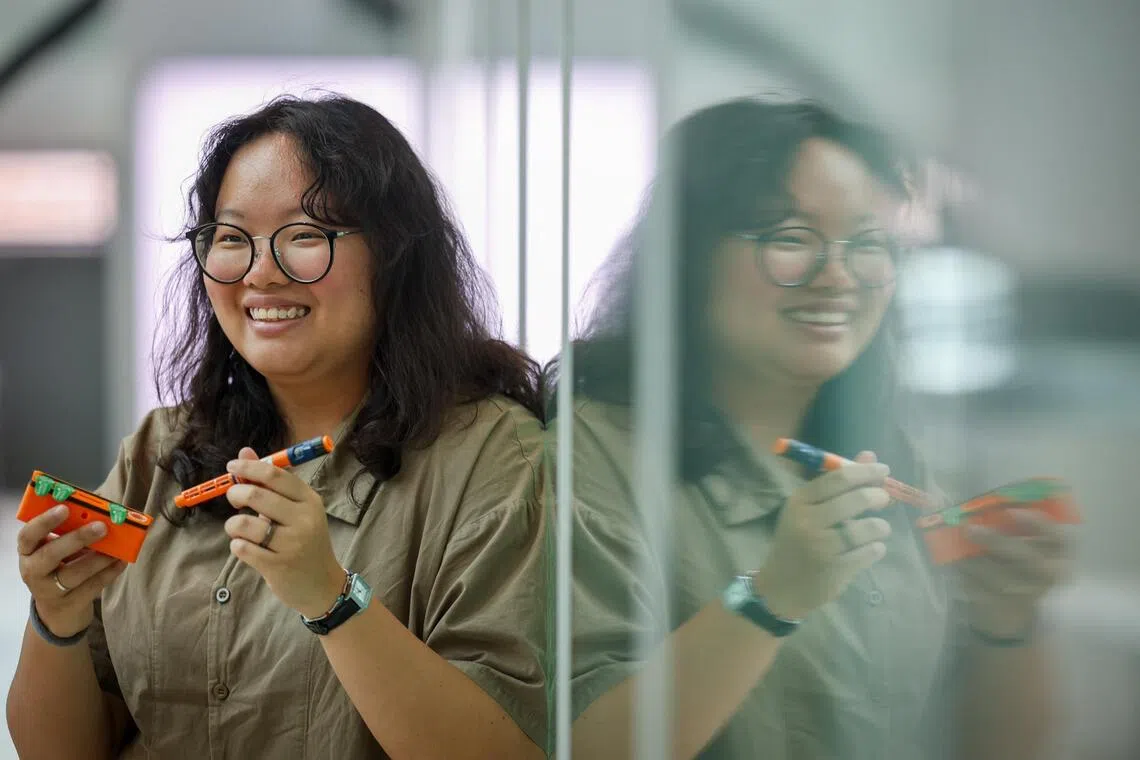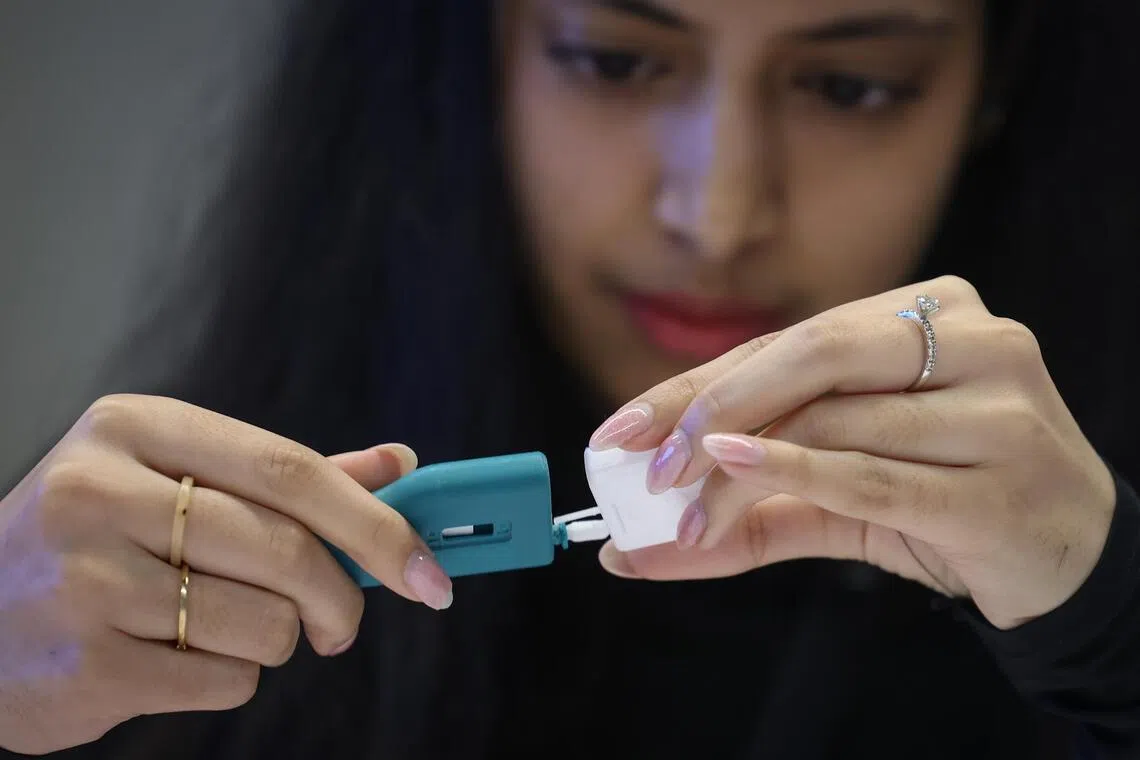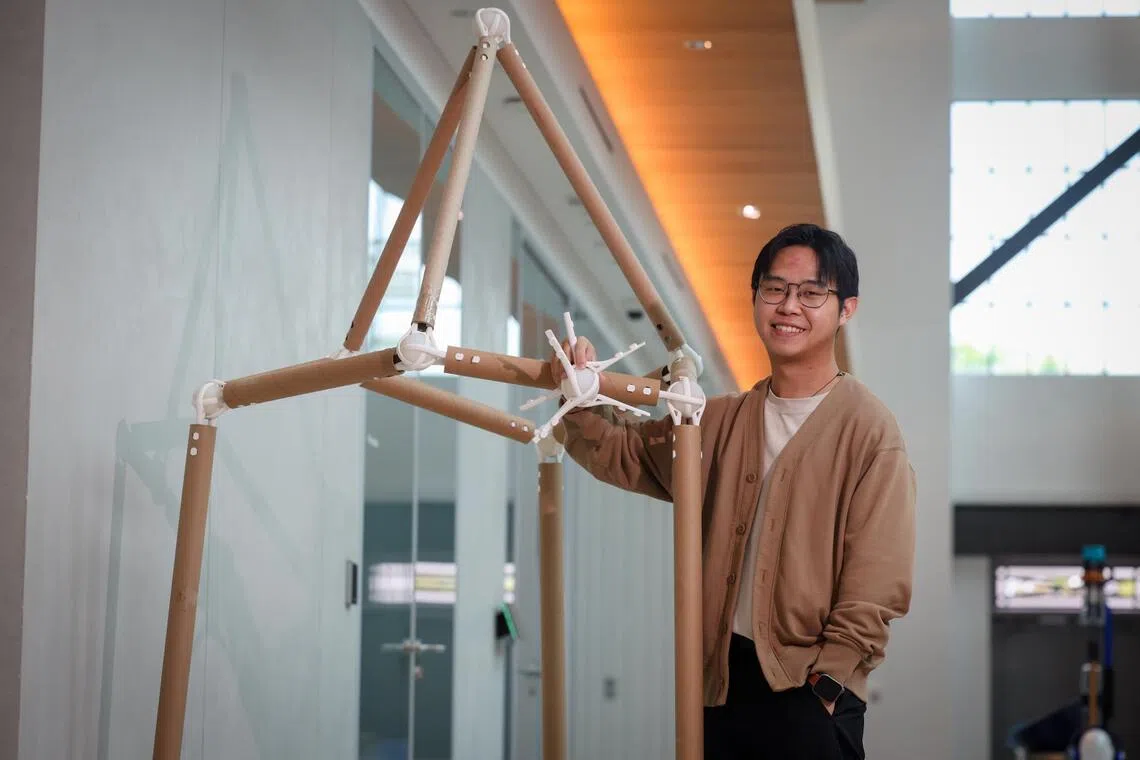Compact needle-carrying device for diabetes patients wins James Dyson Award for Singapore
Sign up now: Get ST's newsletters delivered to your inbox

Singapore winner of the James Dyson Award 2025 Zoey Chan, 23, pictured with her invention, Nido, on Sept 4.
ST PHOTO: JASON QUAH
Follow topic:
- Zoey Chan, diagnosed with Type 1 diabetes, created Nido, a compact device to safely organise and eject insulin needles, addressing the challenges of carrying and disposing of them.
- Chan won the 2025 James Dyson Award for Singapore and $8,400 for Nido's development; the award recognises innovative design engineering students and their ideas.
- Runners-up included Chhavi, a cervical cancer self-test kit and Noda, a joint system for assembling emergency structures, highlighting the societal impact of STEM innovations.
AI generated
SINGAPORE – For Ms Zoey Chan, getting diagnosed with Type 1 diabetes in 2022 when she was just 20 years old precipitated a number of lifestyle changes, not least of which was the need to jab herself with insulin three to five times a day.
Ms Chan soon realised carrying an insulin pen and several needles around every day came with its own challenges, including having to carry around used needles – which need to be disposed of in hard, puncture-resistant containers with secure lids – together with their caps.
To make the process of daily injections safer and easier for those with Type 1 diabetes, she developed a compact device that can safely organise and eject insulin needles, and called it Nido – an acronym for neat insulin daily organiser and a homophone for the word “needle”.
For her invention, Ms Chan was named the 2025 winner of the James Dyson Award for Singapore, winning $8,400 to support Nido’s development.
The international design competition – held annually since 2005 by the James Dyson Foundation, the consumer electronics firm’s charitable trust – recognises innovative ideas developed by current design engineering students in the fields of product design, industrial design and engineering, as well as those who recently graduated.
Ms Chan’s entry and two runners-up for the competition will progress to the awards’ next stage. The international shortlist of 20, selected by a global team of Dyson engineers, will be announced on Oct 15.
The global winners, who will win $50,700, will be chosen by British inventor and entrepreneur James Dyson and announced on Nov 5.
Ms Chan, 23, who recently graduated from the National University of Singapore with a degree in industrial design, described winning the award as a surreal experience. She said: “Two years ago, I wouldn’t even talk about my disease, but now I’m able to bring an awareness to Type 1 diabetes.”
Originally resembling a carrying case for wireless earbuds, Nido’s design was refined through discussions with other diabetics, as well as doctors.
The device can securely hold up to four needles, with compartments for needles of different brands and sizes. It includes a tapered slot that allows users to safely remove the protective needle cap without dropping the needle or pricking their fingers, as well as a slot for used parts and other waste to be discarded.
In Singapore, more than 400,000 people currently live with diabetes – a number that is expected to grow to about one million by 2050.
Aside from Ms Chan’s winning design, this year’s runners-up entries for the Singapore award are a self-test kit for cervical cancer screening and a joint system which enables the rapid assembly of emergency structures for displaced families in areas of humanitarian crises.
All three inventions were chosen for their societal impact and commercial viability, said Dyson senior engineering manager Eddy Teo, one of the judges for the 2025 award.
Such innovations point to the need to keep encouraging young people in the Stem (science, technology, engineering and mathematics) field, so as to “improve lives and build a more compassionate world for everyone”, he said.
The self-test kit for cervical cancer screening, called Chhavi, uses a colour change indicator to enable women in rural areas to get a diagnosis while also allowing users to send a sample to a laboratory for further analysis.

Singapore runner-up of the James Dyson Award 2025 Gunika Jain, 21, pictured with her invention, Chhavi, on Sept 4.
ST PHOTO: JASON QUAH
Chhavi – which means “reflection” in Hindi – was designed by 21-year-old Gunika Jain, who recently graduated with a degree in product design from the Lasalle College of the Arts.
Ms Jain, who also won a Red Dot Design Award for her invention, was inspired to create Chhavi for women in rural India, where almost 80,000 women die annually from the disease.
The other runner-up entry is called Noda.

Singapore runner-up of the James Dyson Award 2025 Reynard Seah, 27, pictured with his invention Noda on Sept 4.
ST PHOTO: JASON QUAH
Centred around an elastic core, the stable joints can support beams of cardboard, plastic or other materials for tents or other structures of varying sizes and shapes, said inventor Reynard Seah, 27, a recent graduate of the NUS’ division of industrial design.
This year saw a bumper crop of entries for the Singapore competition – 93 in all, an increase of about 90 per cent from previous years.
The foundation attributed the big jump in entries to the success of a runner-up for the Singapore award in 2024, airXeed Radiosonde – a more easily retrievable and reusable device in weather balloons to collect measurements for weather forecasts, to help reduce e-waste.
The invention by two Singapore University of Technology and Design post-doctoral research fellows beat nearly 2,000 inventions worldwide to clinch the international James Dyson Award 2024 in the sustainability category


